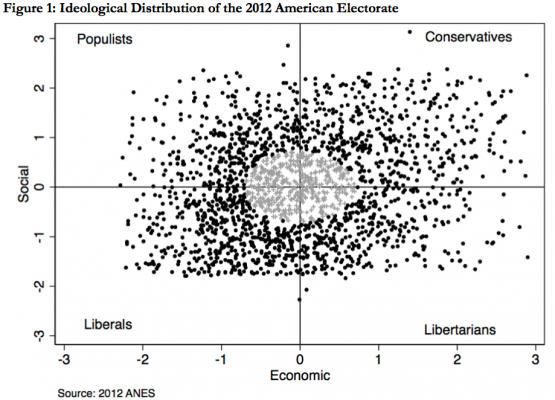New York Times columnist Thomas Friedman, among others, frequently forecasts the rise of a centrist candidate or party that will help move the country past its stubborn left-right divide. There’s some intuitive logic to all of this. After all, if the parties keep moving further and further apart, that theoretically leaves a growing cadre of frustrated centrist voters. The party that articulates their concerns should do quite well. Why does it never happen?
A new paper, “Why American Political Parties Can’t Get Beyond the Left-Right Divide,” by Edwards Carmines, Michael Ensley, and Michael Wagner, helps explain why. The authors presented this paper at the recent State of the Parties conference held at the University of Akron. As the authors explain, the main difficulty in representing the needs of moderates is that moderates aren’t remotely uniform in their preferences: “[M]any of those self-identifying as ideologically moderate are actually polarized from each other – making a centrist third-party’s rise very difficult.”
The authors start off by looking at the 2012 National Election Studies, examining people’s responses to a battery of issue questions. Answers to these questions seem to be organized along two dimensions. The first dimension is economic, basically the traditional divide on questions related to taxation and government regulation of the economy. The second dimension is social, with people arrayed by whether they hold more or less permissive attitudes toward people’s behavior. The chart below shows how respondents were arrayed on these two dimensions:

As can be seen, people exist in all four corners of this chart. At the bottom left, those who want greater government involvement in the economy and a permissive attitude toward social behavior—liberals. At the top right are conservatives, who desire minimal taxation and economic regulation but greater moral order. But there are also plenty of people in the top left (populists) and the bottom right (libertarians). It’s not like all those who want higher taxes have lax social attitudes or anything like that. This is important, as elected officials basically only come in two flavors, liberal or conservative. Yes, you can find the occasional situation in which a Rand Paul will take a libertarian anti-drone stance similar to what some on the left believe, but for the most part, these two dimensions are collapsed into one among officeholders.
That’s not true for voters. As the circle in the center of the graph shows, there are some people who are moderate on both dimensions, but quite a few people are moderate on one dimension but extreme on another. That is, there are some people who are pretty non-committal about economic issues but feel very strongly about their social views.
How does a moderate political party rise to power with the help of moderate voters when so-called moderate voters are actually quite extreme on one dimension? It’s hard. If you don’t really care about changing abortion laws, that might make you appealing to social moderates, but many of those same people feel that taxes should either be much higher or much lower. You take the wrong stance, and you’ve just alienated half of them. Conversely, someone who’s moderate on economic issues might feel very passionate about their civil liberties.
It’s not impossible to be a true moderate on all the major issues of the day, but such people are rare, and the candidate that professes such beliefs will alienate more people than she wins over. In other words, the radical center never rises because, to a large extent, it doesn’t exist.





